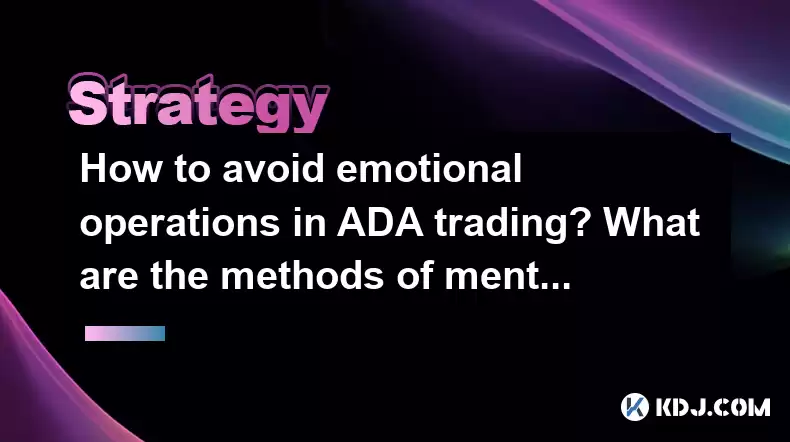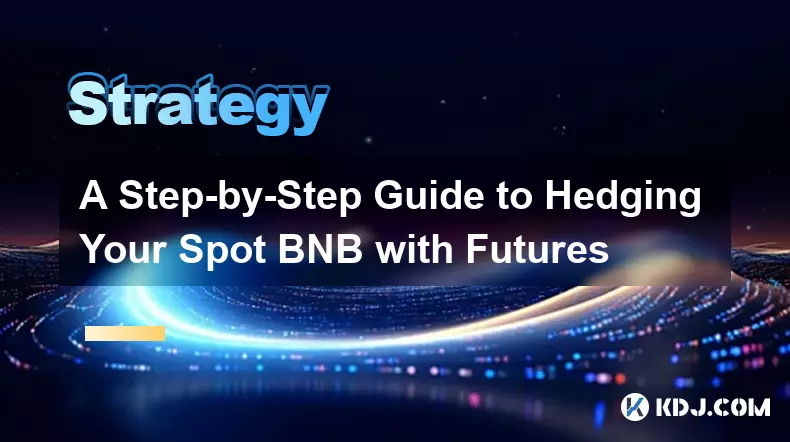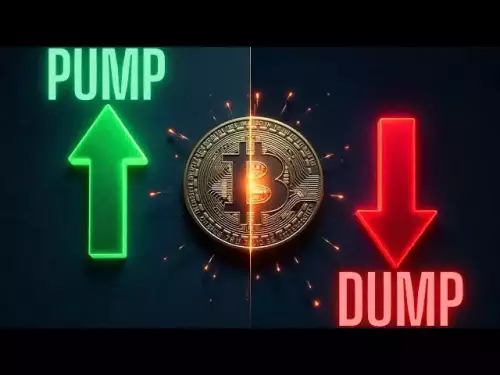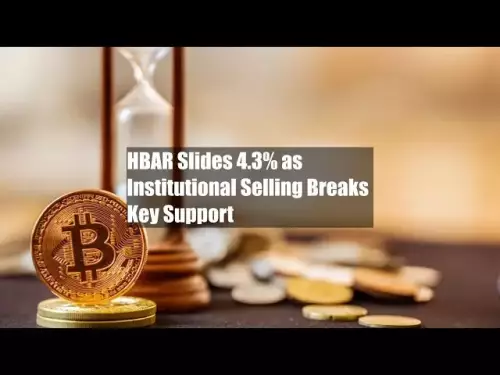-
 bitcoin
bitcoin $114206.058833 USD
-0.82% -
 ethereum
ethereum $4129.796871 USD
-1.31% -
 tether
tether $0.999964 USD
0.00% -
 xrp
xrp $2.640265 USD
-0.68% -
 bnb
bnb $1141.700384 USD
-0.18% -
 solana
solana $200.380665 USD
-2.05% -
 usd-coin
usd-coin $0.999888 USD
0.01% -
 dogecoin
dogecoin $0.200706 USD
-3.43% -
 tron
tron $0.299112 USD
-0.60% -
 cardano
cardano $0.668491 USD
-2.72% -
 hyperliquid
hyperliquid $46.924669 USD
-2.72% -
 chainlink
chainlink $18.286013 USD
-2.66% -
 bitcoin-cash
bitcoin-cash $555.734639 USD
-0.58% -
 stellar
stellar $0.323999 USD
-2.74% -
 ethena-usde
ethena-usde $0.999169 USD
0.00%
How to avoid emotional operations in ADA trading? What are the methods of mentality management?
To avoid emotional trading in ADA, develop a solid trading plan, use technical analysis, manage risks, practice mindfulness, and seek support from trading communities.
Apr 29, 2025 at 08:01 am

Trading Cardano (ADA) can be an exhilarating yet challenging endeavor, especially when emotions come into play. Emotional operations often lead to impulsive decisions that can negatively impact your trading performance. To navigate the volatile cryptocurrency market effectively, it's crucial to manage your emotions and maintain a disciplined approach. This article will explore various strategies to avoid emotional trading and discuss effective methods for mentality management in ADA trading.
Understanding Emotional Trading
Emotional trading refers to making decisions based on feelings rather than logic and analysis. Common emotions that influence trading include fear, greed, hope, and regret. These emotions can lead to actions such as panic selling during market dips or buying at the peak due to FOMO (Fear Of Missing Out).
Recognizing the signs of emotional trading is the first step towards managing it. These signs include making hasty decisions, feeling anxious about market movements, and experiencing significant mood swings based on your trading performance.
Developing a Trading Plan
A well-defined trading plan is essential for avoiding emotional operations. A trading plan outlines your trading goals, risk tolerance, entry and exit strategies, and criteria for selecting trades. By adhering to a plan, you can reduce the influence of emotions on your trading decisions.
- Define your trading goals: Clearly state what you aim to achieve with your ADA trading, whether it's long-term investment or short-term gains.
- Set risk management rules: Determine the maximum amount you're willing to risk on each trade and stick to it.
- Establish entry and exit points: Use technical analysis to identify optimal entry and exit points for your trades.
- Review and adjust your plan regularly: Markets change, and so should your trading plan. Regularly review and adjust your plan to ensure it remains effective.
Utilizing Technical Analysis
Technical analysis is a powerful tool for making informed trading decisions and reducing emotional influence. By focusing on price charts, patterns, and indicators, you can make decisions based on data rather than emotions.
- Learn to read charts: Familiarize yourself with candlestick patterns, support and resistance levels, and trend lines.
- Use indicators: Incorporate indicators like Moving Averages, RSI (Relative Strength Index), and MACD (Moving Average Convergence Divergence) to identify potential trading opportunities.
- Backtest your strategies: Test your trading strategies on historical data to see how they would have performed in the past.
Implementing Risk Management
Effective risk management is crucial for maintaining a stable mindset while trading ADA. By managing your risk, you can prevent significant losses that might trigger emotional responses.
- Use stop-loss orders: Set stop-loss orders to automatically sell your ADA if the price drops to a certain level, limiting your potential losses.
- Diversify your portfolio: Don't put all your eggs in one basket. Diversify your investments to spread risk across different assets.
- Avoid over-leveraging: Be cautious with margin trading and avoid using excessive leverage, as it can amplify both gains and losses.
Practicing Mindfulness and Emotional Awareness
Mindfulness and emotional awareness are key components of mentality management in trading. By staying present and aware of your emotions, you can better control your reactions to market movements.
- Practice meditation: Regular meditation can help you stay calm and focused, reducing the impact of stress and anxiety on your trading decisions.
- Keep a trading journal: Document your trades, including your thought process and emotions at the time of each trade. Reviewing your journal can help you identify patterns and improve your decision-making.
- Take breaks: Step away from the screen regularly to clear your mind and prevent burnout. Trading with a fresh perspective can lead to better decisions.
Seeking Support and Education
Trading can be a lonely endeavor, but seeking support and continuous education can help you manage your emotions and improve your trading skills.
- Join trading communities: Engage with other traders to share experiences, learn from their strategies, and gain emotional support.
- Attend webinars and workshops: Stay updated with the latest trading techniques and market insights by attending educational events.
- Consult with a mentor: Working with an experienced trader can provide valuable guidance and help you navigate emotional challenges.
Frequently Asked Questions
Q: How can I tell if I'm trading emotionally?A: Signs of emotional trading include making impulsive decisions, feeling anxious about market movements, and experiencing significant mood swings based on your trading performance. If you find yourself deviating from your trading plan or reacting strongly to market news, you might be trading emotionally.
Q: Can emotional trading be completely eliminated?A: While it's challenging to eliminate emotional trading entirely, you can significantly reduce its impact by following a disciplined trading plan, practicing mindfulness, and continuously educating yourself about the market.
Q: How often should I review my trading plan?A: It's recommended to review your trading plan at least monthly or whenever there are significant changes in the market or your personal circumstances. Regular reviews ensure that your plan remains relevant and effective.
Q: What should I do if I find myself overwhelmed by trading emotions?A: If you feel overwhelmed, take a break from trading. Step away from the screen, engage in activities that help you relax, and consider seeking support from trading communities or a mentor. It's important to prioritize your mental health and well-being.
Disclaimer:info@kdj.com
The information provided is not trading advice. kdj.com does not assume any responsibility for any investments made based on the information provided in this article. Cryptocurrencies are highly volatile and it is highly recommended that you invest with caution after thorough research!
If you believe that the content used on this website infringes your copyright, please contact us immediately (info@kdj.com) and we will delete it promptly.
- Essex Post Office, 5p Coins, and King Charles: A Royal Mint Revelation!
- 2025-10-23 10:30:16
- Waymo's Newark Airport AV Tests: Alphabet's AI Gamble Pays Off?
- 2025-10-23 10:30:16
- King Charles 5p Coins: A Royal Flush in Your Pocket?
- 2025-10-23 10:35:18
- Solana, Crypto Advisory, and Forward Industries: A New York Minute on the Future of Finance
- 2025-10-23 08:51:22
- MAGACOIN: Ethereum Whales Dive into the Hottest Presale of 2025
- 2025-10-23 08:51:22
- Kadena's End of the Road? KDA Token Plummets Amid Project Abandonment
- 2025-10-23 08:55:34
Related knowledge

A Simple Strategy for Scalping Ethereum (ETH) on the 5-Minute Chart
Oct 25,2025 at 01:54pm
A Simple Strategy for Scalping Ethereum (ETH) on the 5-Minute Chart This strategy focuses on short-term price movements of Ethereum using a 5-minute t...

A Beginner's Guide to Setting Up a Leveraged Ethereum (ETH) Grid Bot
Oct 27,2025 at 03:36pm
Understanding the Basics of a Leveraged ETH Grid Bot1. A leveraged Ethereum grid bot is an automated trading strategy designed to profit from price fl...

A Step-by-Step Guide to Hedging Your Spot BNB with Futures
Oct 27,2025 at 02:18pm
Understanding the Basics of Spot and Futures Markets1. Spot markets involve the immediate exchange of assets, such as BNB, at current market prices. W...

A Guide to Trading Avalanche (AVAX) Perpetual Contracts for Beginners
Oct 25,2025 at 11:36pm
Understanding Avalanche (AVAX) Perpetual Contracts1. Perpetual contracts are a type of derivative product that allows traders to speculate on the pric...

How to Reduce Liquidation Risk on a High-Leverage BNB Position?
Oct 25,2025 at 05:36pm
Understanding Liquidation Mechanics in High-Leverage BNB Trading1. Liquidation occurs when the value of a leveraged position drops to a level where th...

How to Day Trade Bitcoin (BTC) Futures: A Complete Guide
Oct 28,2025 at 12:24am
Understanding Bitcoin Futures and Their Market Mechanics1. Bitcoin futures are derivative contracts that allow traders to speculate on the future pric...

A Simple Strategy for Scalping Ethereum (ETH) on the 5-Minute Chart
Oct 25,2025 at 01:54pm
A Simple Strategy for Scalping Ethereum (ETH) on the 5-Minute Chart This strategy focuses on short-term price movements of Ethereum using a 5-minute t...

A Beginner's Guide to Setting Up a Leveraged Ethereum (ETH) Grid Bot
Oct 27,2025 at 03:36pm
Understanding the Basics of a Leveraged ETH Grid Bot1. A leveraged Ethereum grid bot is an automated trading strategy designed to profit from price fl...

A Step-by-Step Guide to Hedging Your Spot BNB with Futures
Oct 27,2025 at 02:18pm
Understanding the Basics of Spot and Futures Markets1. Spot markets involve the immediate exchange of assets, such as BNB, at current market prices. W...

A Guide to Trading Avalanche (AVAX) Perpetual Contracts for Beginners
Oct 25,2025 at 11:36pm
Understanding Avalanche (AVAX) Perpetual Contracts1. Perpetual contracts are a type of derivative product that allows traders to speculate on the pric...

How to Reduce Liquidation Risk on a High-Leverage BNB Position?
Oct 25,2025 at 05:36pm
Understanding Liquidation Mechanics in High-Leverage BNB Trading1. Liquidation occurs when the value of a leveraged position drops to a level where th...

How to Day Trade Bitcoin (BTC) Futures: A Complete Guide
Oct 28,2025 at 12:24am
Understanding Bitcoin Futures and Their Market Mechanics1. Bitcoin futures are derivative contracts that allow traders to speculate on the future pric...
See all articles










































































